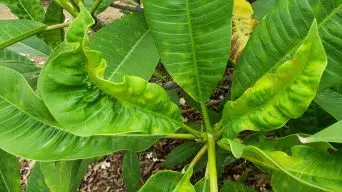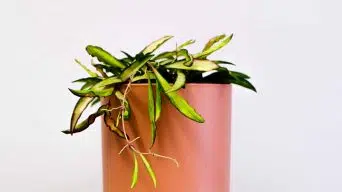Overwatered plumeria plants have brown spots, yellow and soft leaves, wilting, and root and stem rot. They love moisture but can’t survive prolonged exposure to excessive water. Remedies include allowing the soil to dry, using fast-draining soil, and avoiding overwatering.
Plumerias are beautiful and fragrant tropical plants that can instantly transport you to paradise but need the correct water balance to thrive.
Overwatering your Plumeria can lead to root rot, fungal infections, and wilted leaves, putting your beloved plant at risk.
In this blog, we will walk you through identifying the signs of an overwatered Plumeria, how to effectively treat it, and prevent future mishaps.
Identifying Overwatered Plumeria
If you have a plumeria plant and suspect it might be overwatered, there are a few telltale signs to look out for.
Overwatered Plumeria can cause drooping or yellowing leaves, fungus growth, and soft, rotted roots.
Identifying these symptoms early can help you adjust your watering schedule and prevent further damage to your plant.
Drooping Leaves
Drooping leaves on your plumeria plant can be an early sign of overwatering, as the excessive moisture weighs them down and makes it challenging for the plant to respire properly.
For instance, a customer from Central America had their Plumeria thriving outdoors with vibrant flowers throughout the growing season.
However, when she decided to move her plant indoors during winter and maintain regular watering, she noticed that its once-healthy leaves began drooping significantly.
Upon researching various gardening forums and resources, she realized that overwatering was causing harm to her beloved tropical plant.
Yellowing Leaves
Plumeria yellowing leaves are a telltale sign of overwatered Plumeria, often indicating that the plant is not receiving the ideal amount of water required to grow and thrive.
This condition occurs when excess moisture in the soil prevents vital nutrients from being absorbed by the root system, causing leaves to turn yellow and wilt.
To address this issue with your plumeria plant, first, examine its watering schedule and adjust accordingly, ensuring you don’t allow standing water to accumulate around the base of the plant.
Additionally, monitor environmental factors such as humidity levels and sunlight exposure that can contribute to excess moisture retention within the soil.
Fungus Growth
One of the telltale signs of an overwatered plumeria plant is the presence of fungus growth.
Excess moisture provides an ideal environment for fungal infections, such as black tip fungus and plumeria rust, to thrive.
Black tip fungus manifests as dark spots on the tips of leaves and stems, eventually leading to leaf discoloration and rot.
Similarly, plumeria rust appears as orange or yellow powdery spots on the undersides of leaves which gradually spread across the entire leaf surface.
Taking immediate action is crucial if you notice any signs of fungus growth on your plumeria plant.
Adjust your watering schedule, improve soil drainage, remove infected portions, and apply fungicides following label instructions.
Soft, Rotted Roots
Soft, rotted roots are a common symptom of overwatered Plumeria plants.
Overwatering can lead to waterlogged soil that causes the roots to rot and decay.
If left untreated, root rot can spread into the stem and cause further damage.
Adjusting your watering schedule and improving soil drainage to address soft, rotted roots in your Plumeria plant is essential.
Repotting in fresh soil may be necessary in severe cases where significant root decay has already occurred.
Applying fungicides when repotting in fresh soil is essential because soil-borne fungi might infect your Plumeria’s vulnerable roots, leading to more damage overall.
Treating Overwatered Plumeria
If you notice that your Plumeria plants are overwatered, there are several steps you can take to nurse them back to health.
Firstly, adjust the watering schedule, improve soil drainage, and remove excess water.
Additionally, repotting the plant in fresh soil can help promote healthy growth.
If necessary, applying fungicides can also aid in restoring the plant’s health.
Following these simple steps can help your Plumeria plants thrive again.
Adjust Watering Schedule
Adjusting the watering schedule is essential when treating overwatered Plumeria.
Overwatering can lead to the plant’s suffocation and its leaves’ yellowing.
To properly adjust the watering schedule, check the soil’s moisture level with your fingers and water only when dry, about 1-2 inches down.
Generally, it’s recommended to water Plumeria deeply once a week during hot and dry weather but reduce watering frequency during cooler months or if they’re kept indoors with higher humidity levels.
Improve Soil Drainage
Improving soil drainage is crucial to prevent overwatering in Plumeria plants.
One way to achieve this is by using a well-draining potting mix and adding a layer of drainage materials, such as gravel or sand, at the bottom of the pot.
Another option is repotting your Plumeria if it’s currently growing in compacted soil or one that doesn’t drain well.
Ensure you transplant it into fresh, high-quality soil mix with good drainage properties.
By taking these steps, you’ll improve your plant’s health while preventing future damage caused by overwatering.
Remove Excess Water
If you suspect your Plumeria has been overwatered, it is vital to remove any excess water immediately.
This may mean using a towel or sponge to soak up standing water in the plant’s saucer or pot.
If the soil is completely saturated, carefully lift the plant from its container and leave it to dry on some absorbent paper towels for several hours until most moisture has been removed.
Once this step is completed, allow your plumeria plant to dry out completely before watering it again.
Overwatering can cause various issues with plumerias, such as root rot and fungal growth.
Repot In Fresh Soil
If your Plumeria plant is overwatered and suffering from root rot, repotting it in fresh soil to promote healthy growth is essential.
Choose a well-draining potting mix that contains perlite or sand to ensure good drainage.
Gently remove the plant from its current soil, being careful not to damage any still healthy roots.
Trim away any blackened or mushy roots, as these will not recover.
Next, fill the new pot with fresh soil mixture about halfway and place the plant on top, ensuring the roots are spread evenly in all directions.
Fill in the rest of the pot with more soil until it reaches just below the rim, then water lightly and let drain before placing it in a sunny spot.
Apply Fungicides
Fungal infections can quickly take hold of overwatered plumeria plants, causing yellowing leaves and stem rot.
If left untreated, it can ultimately kill the plant.
Fortunately, fungicides are available to help combat these dangerous infections.
Organic fungicides can be used in the early stages of plumeria rust infection and occasionally cure it.
Root-damaged plumerias that need to be replanted can also benefit from a fungicide treatment to clean their roots before planting them in fresh soil.
Remember, applying a fungicide is just one step in adequately treating fungal diseases in your plumeria plant.
It must accompany other measures such as improving soil drainage or adjusting watering schedules correctly depending on the season where your
Plumerias are growing since moisture levels may vary during different periods.
Preventing Overwatering
To keep your Plumeria healthy and thriving, it’s crucial to prevent overwatering.
Instead of simply drenching your plant with water, it’s important to understand its unique water needs, use soil that allows for proper drainage, and adjust your watering schedule based on the time of year.
Avoid watering from above, as this can waterlog the plant’s roots.
By following these guidelines, you can help your Plumeria flourish and prevent any adverse effects caused by overwatering.
Understand The Water Needs Of Plumeria
Plumeria plants are native to tropical regions and have specific water requirements that must be met to thrive.
Overwatering can lead to root rot, which can eventually kill the plant.
To avoid this, Plumeria owners need to understand their plant’s water needs.
Generally, plumerias require regular watering during the growing season and little moisture during winter.
When determining how much water your Plumeria needs, consider its location and soil type.
Plumerias planted in pots may need more frequent watering than those planted directly in the ground due to limited soil volume.
It’s also vital to use well-draining soil that allows excess water to quickly drain away from the roots.
Use Well-draining Soil
To prevent overwatering in your plumeria plant, it’s essential to use well-draining soil.
Plumerias thrive in a slightly acidic soil mix that allows water to flow through easily and not accumulate around the roots.
One way of creating ideal growing conditions is by mixing potting soil with coarse sand or perlite for increased drainage.
Another option would be purchasing a commercial cactus mix- known for its excellent drainage properties.
Adding some orchid bark mixture as a top layer can help hold nutrients while allowing good air circulation.
Water Only When Necessary
Watering your plumeria plant only when necessary is essential, as overwatering is one of the leading causes of root rot.
Plumerias prefer drier soil conditions and are susceptible to fungal diseases in damp environments.
To determine if your plant needs watering, stick your finger into the soil about an inch deep.
If it feels dry, then it’s time to water the plant.
It’s important not to rely solely on a set schedule for watering your plumeria plants because various factors can impact how frequently they need watering.
For example, plants may require less frequent watering during cooler months or low humidity periods than during their active growing season when temperatures and humidity levels are higher.
Avoid Watering From Above
When watering your plumeria plant, avoiding watering from above is important.
This means that you should avoid using a sprinkler or spraying water directly onto the leaves and flowers of the plant.
Watering from above can lead to stagnant water accumulation around the roots, which can cause root rot and other fungal infections.
By watering at the base of the plant, you allow water to reach the roots without soaking in excess moisture on top of the soil surface.
Another reason avoiding overhead watering is crucial for Plumeria is because its leaves hold excess moisture, creating an environment conducive for black tip fungus or other diseases like rust fungi.
Adjust Watering Schedule During Different Seasons
Plumeria’s water requirements vary depending on the season.
During the growing season in spring and summer, when plumeria trees are actively growing and producing new leaves and flowers, they require more water than during the dormant stage in fall and winter.
Overwatering during dormancy can lead to root rot and other fungal diseases.
Adjusting your watering schedule according to each season’s needs is crucial to prevent over or underwatering your plumeria plant.
Final Thoughts
Overwatered Plumeria plants are at risk of root rot, which can be a severe problem for owners.
Proper identification, treatment, and prevention can save these beautiful tropical plants from wilting and yellowing leaves or even dying.
Remember to adjust watering schedules based on the season and use well-draining soil in pots or garden beds.
If you notice signs of overwatering, like rotting roots or fungus growth, remove excess water, repot in fresh soil, and apply fungicides as necessary.







